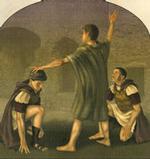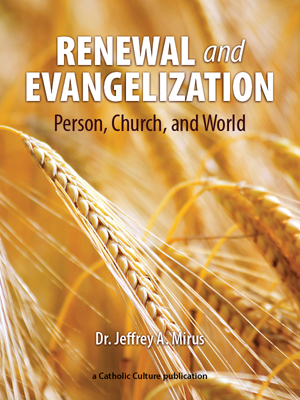The Assumption, Tradition, and a Pledge for You and Me
By Dr. Jeff Mirus ( bio - articles - email ) | Aug 15, 2012
The Feast of the Assumption calls to mind the importance of Tradition as a source of Revelation, and the importance of the Magisterium as the only authority that can determine what is part of Sacred Tradition, and what is not. There is, of course, a strong argument for the “fittingness” of the Assumption, but “fittingness” is the weakest possible philosophical or theological argument. While we ought to be able to see from Catholic doctrine that God acts in “fitting” ways, Church teaching is never based on human notions of “fittingness”. It is based on what God has revealed.
Thus it is certainly fitting that God should honor the mother of His Son by sparing her the corruption of death and bringing her body and soul into heaven to be with her Son and Lord for all eternity. But beyond fittingness, there is also a strong theological connection between Mary’s freedom from the corruption of death and her Immaculate Conception, a dogma which was defined prior to that of the Assumption. One can argue that if Mary were free from Original Sin, she had to have been free from the interior effects of that Sin, including the corruption of death. Her death (if it happened at all) would have been more of a peaceful “falling asleep”, as in the Eastern tradition of her Dormition. She could not, presumably remain in the grave and decay. But in earlier times, not even the Immaculate Conception was defined. That did not happen until 1854, and there were some fine theologians (Thomas Aquinas among them) who thought, on balance, that Mary was not immaculately conceived. Therefore, the history of the dogma of the Assumption compels us to return to Tradition.
What we find is that the Assumption is independently mentioned in quite a few apocryphal documents purporting to be very early, and mentioned in writings that can be traced definitively back at least as early as the fifth century, and perhaps to the fourth. Liturgical celebrations of a Feast of the Assumption can be traced to a similar period. Far from suggesting the Assumption was a “late” development, the fact that so much has been lost from the first few hundred years of Church history makes it likely that many Catholics recognized and believed in the Assumption far earlier, and that this was expressed in the way they worshipped.
In other words, the idea that Mary was assumed body and soul into heaven is found in the Church at an early date, it circulated widely, and it was gradually recognized by all (that is, “all” in the moral sense of the term). For example, by the time Pope Benedict XIV (1675 – 1758) wrote his treatise on the feasts of Christ and the Virgin Mary, he was able to state that the Assumption was a probable opinion which, at the very least, it would be impious and blasphemous to deny. Roughly a century later, Pope Pius IX, who received increasing numbers of petitions to proclaim the Immaculate Conception, polled the world’s bishops concerning the Assumption. Ninety percent of them requested that the Assumption be proclaimed a dogma as well.
Pius did proclaim the Immaculate Conception in 1854. Interestingly, six years earlier he had already granted the request of the American bishops to make Mary the patron of the United States under her title of the Immaculate Conception—a reminder that there is much implicit in Tradition which may go undefined. A few years later, at Vatican I, an effort to dogmatize the Assumption was resisted primarily by the German bishops, and even the Pope was leery of proclaiming two Marian dogmas within so short a time span. But there is no question, as we have already seen, that the theological understanding of the Assumption is tied to the Immaculate Conception. The proclamation of the one threw the other into sharper relief. So from this point on, perhaps, it was just a matter of time.
In any case, after another century’s delay, Pope Pius XII proclaimed the dogma of the Assumption in 1950 in Munificentissimus Deus. In this, of course, he was not making up anything new. He was responding to constant requests from Catholics, especially bishops, around the world who firmly believed the Assumption was part of Divine Revelation, known to the Church from Tradition. His ultimate decision was that this is in fact the case.
While the dogma of the Assumption is not based on any theoretically indisputable passage in Scripture, it is interesting how many passages in Scripture can be read as referring to the Assumption in the light of Faith. Chief among these is the “great portent” which “appeared in heaven, a woman clothed with the sun…; and she was with child” (Rev 12:1-2). When the woman and her child were taken beyond the dragon’s grasp, he “was angry against the woman, and went off to make war against the rest of her seed” (Rev 12:7). Among other passages which preachers, theologians, bishops and popes down through the ages have applied to the Assumption are these:
- Genesis 3:15: “I will put enmity between you and the woman, and between your seed and her seed; he shall bruise your head, and you shall bruise his heel.” [Here we have the initial revelation of Mary’s unique position.]
- Psalms 45:9-17: “[D]aughters of kings are among your ladies of honor; at your right hand stands the queen in gold of Ophir. Hear, O daughter, consider, and incline your ear; forget your people and your father's house; and the king will desire your beauty. Since he is your lord, bow to him; the people of Tyre will sue your favor with gifts, the richest of the people with all kinds of wealth. The princess is decked in her chamber with gold-woven robes; in many-colored robes she is led to the king, with her virgin companions, her escort, in her train. With joy and gladness they are led along as they enter the palace of the king. Instead of your fathers shall be your sons; you will make them princes in all the earth. I will cause your name to be celebrated in all generations; therefore the peoples will praise you for ever and ever.” [Mary’s reign in heaven.]
- Psalms 132:8: “Arise, O LORD, and go to thy resting place, thou and the ark of thy might.” [For Mary is regarded by the Church as the new ark of the covenant.]
- Song of Songs 3:6: “What is that coming up from the wilderness, like a column of smoke, perfumed with myrrh and frankincense, with all the fragrant powders of the merchant?” [Thus, Our Lady rising to heaven....]
- Song of Songs 4:8: “Come with me from Lebanon, my bride; come with me from Lebanon. Depart from the peak of Ama'na, from the peak of Senir and Hermon, from the dens of lions, from the mountains of leopards.” [The Holy Spirit calling Mary to Himself.]
- Song of Songs 6:9: “My dove, my perfect one, is only one, the darling of her mother, flawless to her that bore her. The maidens saw her and called her happy; the queens and concubines also, and they praised her.”
- Song of Songs 8:5: “Who is that coming up from the wilderness, leaning upon her beloved?”
- Isaiah 60:13: “The glory of Lebanon shall come to you, the cypress, the plane, and the pine, to beautify the place of my sanctuary; and I will make the place of my feet glorious.” [For Mary is regarded as the sanctuary and ‘the place of Christ’s feet’ (where His body was formed).]
- Luke 1:28: “And he came to her and said, ‘Hail, full of grace, the Lord is with you!’” [the angelic salutation]
- John 14:3: “And when I go and prepare a place for you, I will come again and will take you to myself, that where I am you may be also.”
- 1 Corinthians 15: “For as by a man came death, by a man has come also the resurrection of the dead. For as in Adam all die, so also in Christ shall all be made alive. But each in his own order: Christ the first fruits, then at his coming those who belong to Christ. Then comes the end, when he delivers the kingdom to God the Father after destroying every rule and every authority and power. For he must reign until he has put all his enemies under his feet. The last enemy to be destroyed is death.”
One may read Munificentissimus Deus to see how the Pope applies these passages. In the last two, of course, what is done for Mary in a special way is a sign and a promise for us all. Indeed, the Assumption of the Immaculata may rightly be taken as a pledge for us sinners. May God, in his surpassing generosity, be forever praised!
All comments are moderated. To lighten our editing burden, only current donors are allowed to Sound Off. If you are a current donor, log in to see the comment form; otherwise please support our work, and Sound Off!
-
Posted by: Jeff Mirus -
Aug. 20, 2012 6:08 PM ET USA
mclom2107: Yes, both Elijah (2 Kings 2:11) and the Patriarch Enoch (Genesis 5:24; cf. Hebrews 11:5; Sirach 46:16, 49:14) are revealed in Scripture to have been taken up into Heaven body and soul. These instances make it even more likely that Our Lord would have granted the same privilege to His own mother, who was full of grace.
-
Posted by: mclom -
Aug. 19, 2012 4:06 PM ET USA
Thank you very much for this article. I learned a lot from it. May I ask, was the prophet Elijah also assumed? It does sound like it when one reads how he was caught up. I cannot find the passage but feel sure it is there.








